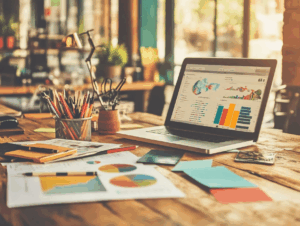We all want to know if our recycling efforts actually make a difference. Unfortunately, today’s recycling systems can’t give us a clear answer. The truth is, we don’t really know how much of what goes into our recycling bins actually gets recycled.
The problem is simple: current recycling tracking lacks transparency and reliability. When materials move from collection points to processing facilities, the data gets fuzzy. Cities report their numbers differently, companies use various tracking methods, and there’s little verification along the way.
This article explores how blockchain could transform recycling tracking, making the process more transparent and accountable for everyone involved.
What’s going on with the recycling now
Recycling tracking relies primarily on weight measurements and self-reported data. When recycling trucks collect materials from your neighborhood, they simply weigh their loads before and after collection. These basic measurements become the foundation for recycling statistics, but they miss crucial details about what actually happens to these materials.
Flawed tracking methods
Weight-based tracking doesn’t account for contamination – non-recyclable items mixed in with recyclables. More importantly, once materials change hands between collectors, sorting facilities, processors, and manufacturers, visibility is lost. There’s no connected system to verify that collected materials complete their journey to become new products.
Supply chain complications
The recycling process involves multiple independent players with separate tracking systems. Each transfer point introduces potential data gaps. Contamination might only be discovered during sorting, market conditions can make certain materials unprofitable to process, and international shipping creates additional tracking challenges.
Need for transparency
This lack of reliable data affects everyone. Consumers grow skeptical about whether their sorting efforts matter. Municipalities struggle to set realistic targets or measure program effectiveness. Manufacturers can’t easily verify the source and quality of recycled materials they purchase. And without clear insights into where the system breaks down, it’s difficult to make targeted improvements that could increase actual recycling rates.
What’s needed is a system that can track materials throughout their entire journey, providing verification at each step and creating accountability for all participants in the recycling process.
How blockchain works
At its core, blockchain is a special type of record-keeping system. Think of it as a digital ledger that keeps track of transactions or events, but with some important differences from traditional databases. Instead of storing all information in one central location, blockchain spreads identical copies of this ledger across many computers (called nodes) in a network.
When someone wants to add new information – like recording that a bale of plastic was transferred from a sorting facility to a processor – this new “block” of data is first verified by multiple computers in the network. Once verified, the block is added to the existing “chain” of records. Each new block contains a reference to the previous one, creating an unbroken chain of information.

What makes blockchain especially suitable for recycling tracking are three key characteristics:
- Immutability. Once information is added to the blockchain, it cannot be altered or deleted. This permanence means recycling data can’t be manipulated after the fact to make performance look better than it is.
- Transparency. Everyone with access to the blockchain can see the same information. This shared visibility allows all parties – from collection services to processors to regulators – to access identical data.
- Decentralization. No single entity controls all the data. This distributed approach prevents any one participant from controlling or manipulating the information.
Blockchain in recycling systems
Blockchain creates a backbone that connects all stages of the recycling process. This technology isn’t just theoretical – it offers practical applications that could transform how recycling works.
Creating digital identities for materials
The first step is creating digital identities for physical materials. This might involve QR codes on recycling bins or radio-frequency identification (RFID) tags on bales of sorted materials. When recyclables are collected, their initial information – weight, type, location, time – is recorded as the first entry on the blockchain. As these materials move through the system, each handler updates the blockchain, building a complete history.
Automating verification through smart code
Blockchain systems can use “smart contracts” – self-executing agreements with the terms written directly into code – to automate recycling verification. These contracts automatically confirm when conditions are met without requiring manual approval.
A smart contract might automatically verify that a shipment of glass arrived at a processing facility by checking weight records and location data. If the data matches expectations, the contract executes automatically, potentially triggering payment to the transportation company and updating inventory records for the receiver.
Building reward systems that work
Blockchain enables tamper-proof reward systems that can encourage better recycling habits. When consumers or businesses recycle properly, they receive digital tokens as verifiable rewards that might offer discounts, tax benefits, or even monetary value.
Some communities are already testing recycling rewards programs, but blockchain makes these systems more resistant to fraud since the entire process – from collection to verification to reward distribution – is recorded permanently.
Tracking materials from bin to new product
The most powerful feature of blockchain in recycling is complete traceability. Manufacturers can verify exactly where their recycled materials originated and how they were processed. Consumers can potentially scan products to see verified recycled content information. Government agencies gain reliable data to measure actual sustainability progress, rather than depending on estimates and self-reporting that can be manipulated or inaccurate.
Benefits of blockchain for recycling stakeholders
Blockchain technology offers specific advantages for each participant in the recycling ecosystem. This creates a system where everyone benefits from increased transparency and accountability.

For municipalities
Cities and local governments gain access to more accurate recycling data, allowing them to make evidence-based decisions about their waste management programs. Instead of relying on estimates or self-reported figures, officials can see exactly how much material is being recycled and identify where materials are being lost in the process.
This improved visibility helps municipalities allocate resources more effectively. If data shows that certain neighborhoods have high contamination rates, education efforts can be targeted there. If specific materials consistently fail to complete the recycling journey, collection strategies can be adjusted. Accurate data also helps municipalities report honestly to constituents and regulatory bodies about their sustainability progress.
For recycling facilities
Blockchain provides real-time inventory tracking, reducing administrative overhead and paperwork. When materials arrive with digital identities already established, intake processes become more efficient.
Blockchain records also help facilities demonstrate compliance with environmental regulations and quality standards. Rather than undergoing time-consuming audits, facilities can provide verifiable records of their operations. This digital certification can become a competitive advantage when bidding for municipal contracts or selling processed materials to manufacturers.
For manufacturers
Companies that use recycled content in their products gain reliable verification of their supply chains. With blockchain, manufacturers can trace materials back to their source, confirming that what they purchase as “recycled content” truly is recycled. This traceability helps companies confidently report on Environmental, Social, and Governance (ESG) metrics that investors and consumers increasingly demand.
Manufacturers can also use blockchain records to substantiate marketing claims about recycled content, protecting themselves from accusations of “greenwashing” while building consumer trust in their sustainability efforts.
For consumers
Everyday recyclers gain something they’ve long wanted: confirmation that their efforts matter. Blockchain-based systems could allow consumers to track their community’s recycling performance or even their household’s individual impact. Mobile apps could scan product packaging and show consumers where and how similar packaging has been successfully recycled.
Reward systems built on blockchain can provide tangible motivation for proper recycling, whether through discounts, recognition, or even financial rewards. These systems work because blockchain ensures rewards are distributed fairly based on verified actions, not just claims.
Implementation challenges and solutions
Despite its potential benefits, implementing blockchain in recycling systems faces several real-world obstacles. Understanding these challenges is essential for developing practical solutions.
Technical barriers
The recycling industry operates largely in the physical world, making digital integration challenging. Many facilities use legacy equipment and paper-based records. Connecting these physical processes to blockchain requires additional technology like sensors, scanners, and IoT devices. There’s also the question of technical expertise – many recycling operations lack personnel with blockchain experience.
One promising solution is the development of simplified interfaces that don’t require specialized knowledge. Just as website builders allow people to create websites without coding, blockchain platforms specifically designed for recycling could offer intuitive dashboards and automated data collection that works with existing processes.
Cost considerations
Implementing any new technology system requires investment. For smaller recycling operations with tight margins, the upfront costs of blockchain implementation may seem prohibitive. Hardware, software, training, and maintenance all represent new expenses.
The most viable approach is starting with small-scale pilot programs that demonstrate value before expanding. Public-private partnerships can also help distribute costs, with municipalities, processors, and manufacturers sharing investment in a system that benefits all parties.
Regulatory framework
The recycling industry operates under various regulations that differ by region. Blockchain systems need to accommodate these regulations, while also potentially introducing new compliance considerations around data privacy and reporting standards.
Working with regulators early in the development process is crucial. Some jurisdictions are already exploring blockchain for environmental reporting, creating opportunities to align new systems with evolving regulatory frameworks. Rather than seeing regulation as an obstacle, blockchain developers should view it as a design parameter.
Conclusion and future outlook
Blockchain technology offers a promising solution to the recycling industry’s long-standing transparency problems. By creating verifiable records that follow materials from collection through processing to reuse, blockchain can help build trust in recycling systems and improve actual recycling rates.
Looking ahead, blockchain is likely to become just one part of a more connected recycling ecosystem. Combined with other emerging technologies like artificial intelligence and advanced sorting equipment, blockchain could help create truly circular material flows that maximize recovery and minimize waste.
Ready to explore how blockchain could improve your recycling operations? Contact us today to develop a focused pilot project.
Chapters
- What’s going on with the recycling now
- How blockchain works
- Blockchain in recycling systems
- Benefits of blockchain for recycling stakeholders
- Implementation challenges and solutions
- Conclusion and future outlook



